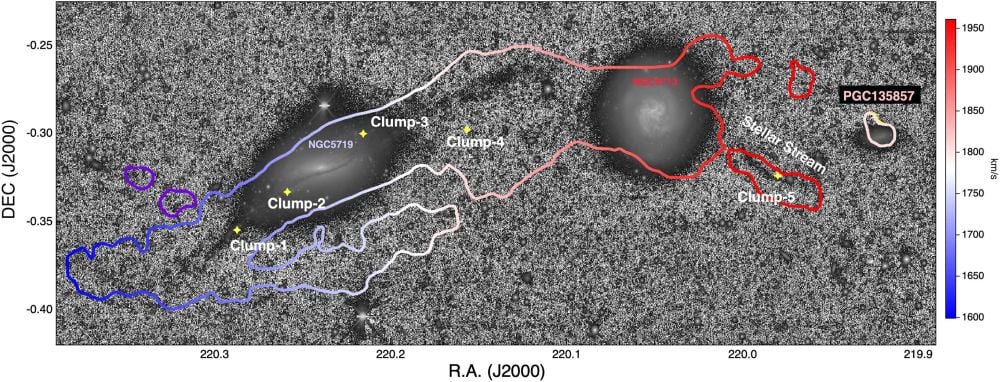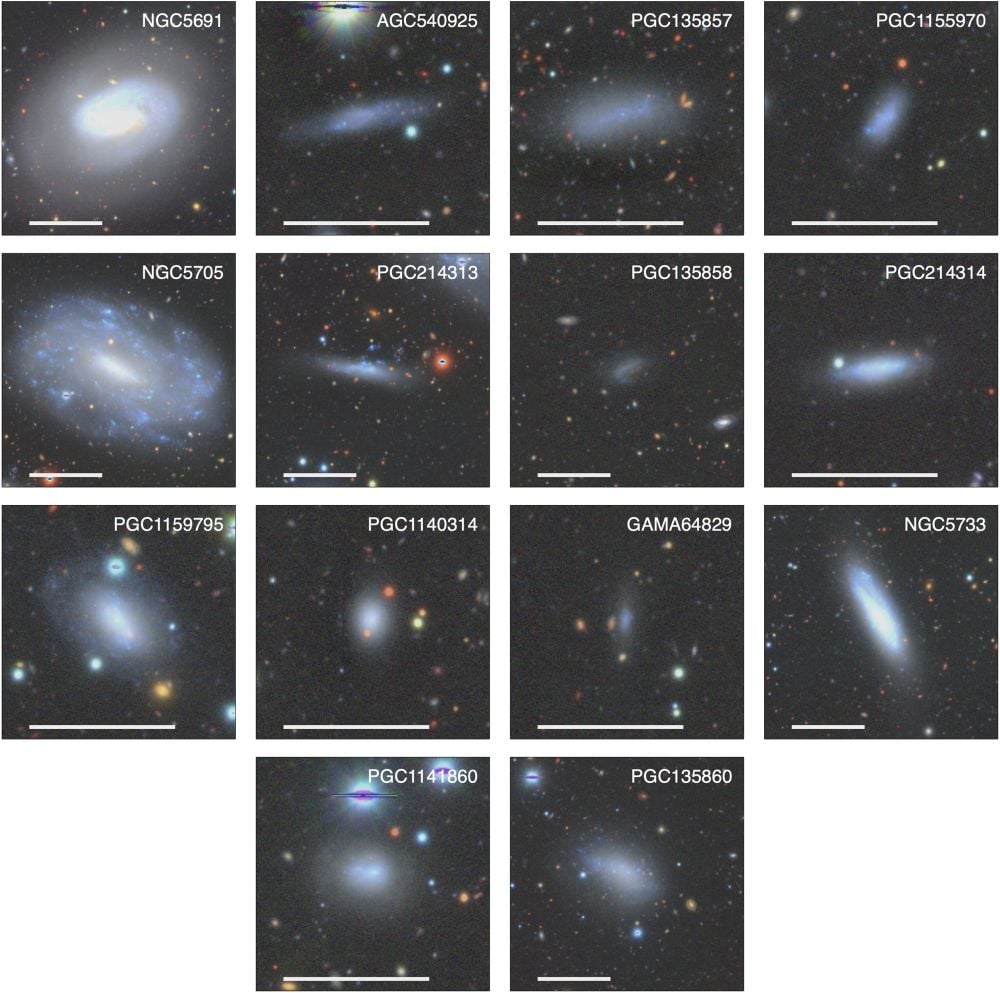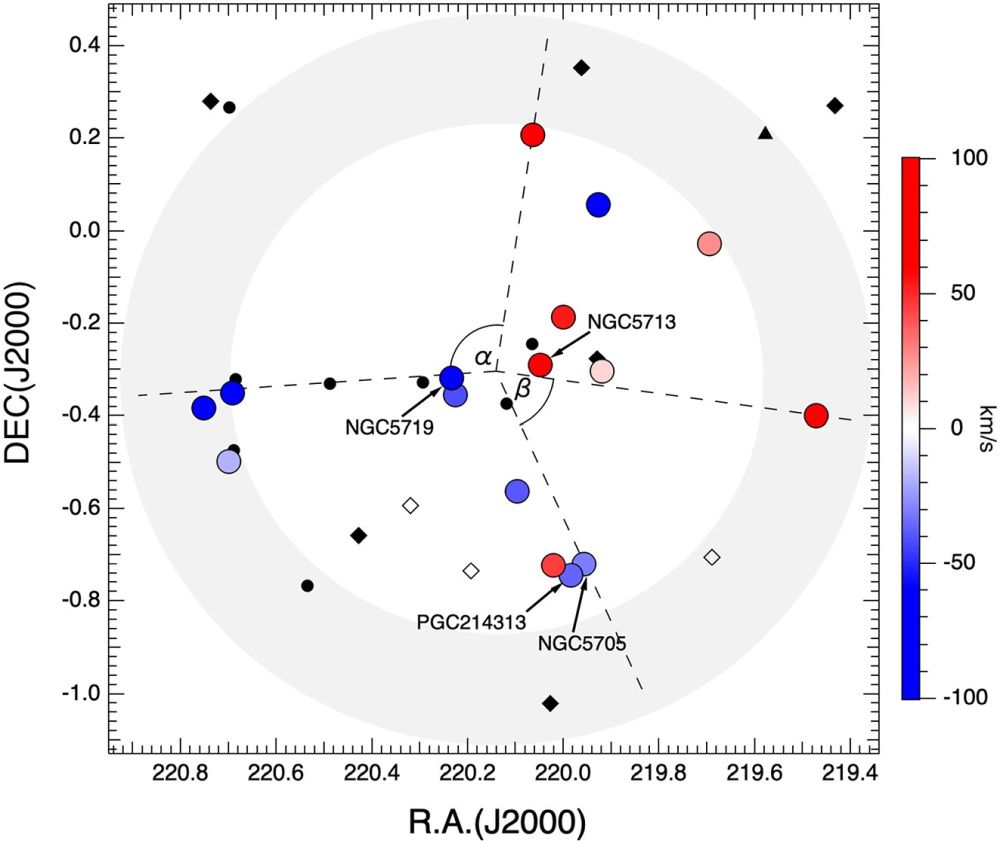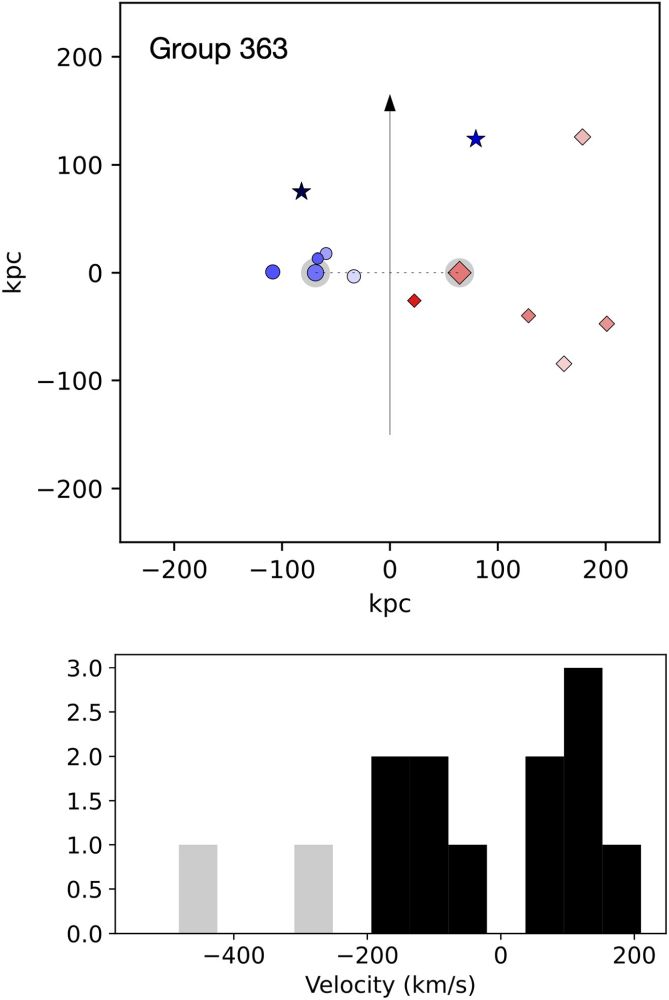Astronomers are confident that the Milky Way and Andromeda galaxies will collide, merge, or at least interact with one another in the next few billion years. What will that merger look like? Both galaxies have dwarf galaxies, and astronomers want to know if their behaviour can predict the future of the merger.
One way astronomers probe these questions is with advanced simulations. But astronomers at Australia's University of Queensland are working on another way to understand the merger: by studying a different pair of galaxies that are further along the merger timeline.
Their results are in a paper titled "The coherent satellite velocity field around the interacting spiral galaxy pair NGC5713/19: signature of two galaxy groups merging." It's published in the Monthly Notices of the Royal Astronomical Society, and the lead author is Helmut Jerjen. Jerjen is a professor of Astronomy and Mathematics at Australia National University.
"This paper shows these galaxies - NGC5713 and NGC5719 - combine as if they were dancing with the closely located dwarf satellites rotating around them." - Dr. Sarah Sweet, ANU.
NGC 5713 and 5719 are an interacting pair of luminous spiral galaxies about 300,000 light-years apart. NGC 5713/19 are similar enough to the Milky Way and Andromeda to provide a useful reference. They're further along in their merger, and there's already evidence of enhanced star formation as the two galaxies interact.
A straight, elongated structure of neutral hydrogen connects them, and extends over 650,000 light-years. That means a tidal bridge spans the pair, which is clear evidence of their gravitational interactions stripping material from the galaxies.
 This figure shows the inner 200 kiloparsecs around NGC5719 (left) and NGC5713 (right). Prominent stellar streams protrude on both sides of NGC5719, following the directions of its warped disc. Clumps-1 and 2 are pockets of young stars forming in the stellar stream east of NGC5719 reported in previous research. The image also reveals a previously unknown stellar stream that coincides with the western H i tail that connects NGC5713 with the dwarf PGC135857. The dwarf galaxy most likely emerged from the tidal debris of the interaction between the NGC 5713/19 pair. The image also shows three newly-identified clumps 3, 4, and 5. Image Credit: Jerjen et al. 2025. MNRAS.
This figure shows the inner 200 kiloparsecs around NGC5719 (left) and NGC5713 (right). Prominent stellar streams protrude on both sides of NGC5719, following the directions of its warped disc. Clumps-1 and 2 are pockets of young stars forming in the stellar stream east of NGC5719 reported in previous research. The image also reveals a previously unknown stellar stream that coincides with the western H i tail that connects NGC5713 with the dwarf PGC135857. The dwarf galaxy most likely emerged from the tidal debris of the interaction between the NGC 5713/19 pair. The image also shows three newly-identified clumps 3, 4, and 5. Image Credit: Jerjen et al. 2025. MNRAS.
The NGC 5713/19 pair has 14 confirmed dwarf satellite galaxies, and they and the two larger host galaxies form two distinct sub-groups. In their paper, the researchers explain that the dwarves and their hosts have a "prominent coherent kinematic structure." This means they move through space in an organized, systematic pattern. These observations provide clues to the pair's gravitational history, how long they've been interacting, how dark matter is distributed, and what role tidal forces have had in shaping orbits.
 These panels show the 14 confirmed dwarf galaxies in the system. Image Credit: Jerjen et al. 2025. MNRAS.
These panels show the 14 confirmed dwarf galaxies in the system. Image Credit: Jerjen et al. 2025. MNRAS.
Dr. Sarah Sweet is from the ANU's School of Mathematics and Physics. She's leading Delegate, a collaborative survey with the Australian National University’s Research School of Astronomy and Astrophysics and other institutions. Delegate tries is to understand how dwarf galaxies interact with their larger spiral hosts. The goal is to understand how the Milky Way and Andromeda will merge in the future.
“The Milky Way will merge with Andromeda and their respective smaller dwarf galaxies in the next 2.5 billion years and while there has been a lot of research into what’s happening in our Local Group, we don’t know how typical it is,” Dr Sweet said in a press release. “We studied 2 similar spiral galaxies that are about 3 billion years ahead of the Milky Way and Andromeda in merging. This paper shows these galaxies - NGC5713 and NGC5719 - combine as if they were dancing with the closely located dwarf satellites rotating around them."
 This is the on-sky distribution of the NGC5713/19 pair with its 14 satellite galaxies and illustrates their coherent structure. The satellites occupy two well-defined wedge-shaped regions. Satellites with known velocities are colour-coded by their velocity. All blueshifted galaxies except one are found in the wedge to the south-east, including NGC5719 itself. To the north-west are all but one redshifted satellites as well as NGC5713. This leaves two wide sectors where no satellite with known velocity resides in. Image Credit: Jerjen et al. 2025. MNRAS.
“Without such a merger, the galaxies might remain in a randomly distributed cloud, not arranged in beautiful, coherent planes like those around the Milky Way and Andromeda," said Sweet. "This may offer our clearest look yet at how structures like the Milky Way's satellite system form, and how they will evolve."
This is the on-sky distribution of the NGC5713/19 pair with its 14 satellite galaxies and illustrates their coherent structure. The satellites occupy two well-defined wedge-shaped regions. Satellites with known velocities are colour-coded by their velocity. All blueshifted galaxies except one are found in the wedge to the south-east, including NGC5719 itself. To the north-west are all but one redshifted satellites as well as NGC5713. This leaves two wide sectors where no satellite with known velocity resides in. Image Credit: Jerjen et al. 2025. MNRAS.
“Without such a merger, the galaxies might remain in a randomly distributed cloud, not arranged in beautiful, coherent planes like those around the Milky Way and Andromeda," said Sweet. "This may offer our clearest look yet at how structures like the Milky Way's satellite system form, and how they will evolve."
The researchers are comparing the Milky Way/Andromeda pair to other galaxy pairs to try to understand how representative the MW/Andromeda pair is of other mergers.
"“We will test whether the Milky Way and Andromeda Local Group is a poster child or a cosmic outlier,” lead author Jerjen said. “Until we know this, our ability to generalize findings from the Local Group of galaxies to understand galaxy evolution in a broader cosmological context is hampered."
In astronomy, astrophysics, and cosmology, there's often tension between our theoretical understanding and our observations. This is entirely normal and expected, since our knowledge of Nature is incomplete. But when scientists detect that tension, they know it's time to get to work. It usually indicates that our models and theories need more refining before they line up with Nature.
“For example, there is persisting tension between local galaxy group observations and the world’s most sophisticated cosmological computer simulations, such as the observed placement of dwarfs preferentially in satellite planes around their hosts," said Jerjen. “These observations suggest we need to overhaul current simulations."
The researchers turned to the well-known Illustris TNG100 cosmological simulation to test their observations and search for analogues of the NGC5713/19 group. They found eight of them within the simulation's volume. One of the galaxy pair's in the simulation was very similar to the NGC5713/19 in terms of co-rotation.
 These panels show the simulated galaxy that is most similar to the NGC5713/19 pair. The hosts are highlighted by a grey outline and are presented either as a circle or diamond. The bottom panel shows the LOS relative velocity distribution, with non-associated satellites shown in grey. "We note that Group 363 closely resembles the NGC5713/19 group with a bimodal LOS velocity distribution," the authors write. Image Credit: Jerjen et al. 2025. MNRAS.
These panels show the simulated galaxy that is most similar to the NGC5713/19 pair. The hosts are highlighted by a grey outline and are presented either as a circle or diamond. The bottom panel shows the LOS relative velocity distribution, with non-associated satellites shown in grey. "We note that Group 363 closely resembles the NGC5713/19 group with a bimodal LOS velocity distribution," the authors write. Image Credit: Jerjen et al. 2025. MNRAS.
"The merging galaxy pair NGC5713/19 was found to have a satellite system with a distinct bimodal distribution in terms of sky positions and relative line-of-sight velocities, with all but one satellite south east of NGC5719 being blueshifted and all but one satellite north-west of NGC5713 being redshifted," the researchers write in their conclusion. "They also follow the same motion as their nearby host galaxies."
There are several scenarios that can explain the findings. But the authors conclude the merger scenario is most likely. Follow-up observations can confirm this, and the authors say that measuring chemical abundances in the tidal tail and comparing it to the mass–metallicity relation could help confirm the merger scenario. If the dwarf at the end of the tail has the same metallicity as the tidal stream, that helps confirm that it emerged from the merger.
It the NGC5713/19 pair is definitely a merging pair, then the behaviour of its dwarfs could help us understand what the Milky Way's merger future is like.
"Will the Milky Way begin its own dance with Andromeda with the smaller dwarf galaxies rotating around them? That’s what we want to find out,” Professor Jerjen concluded.
To see a video of the simulated 'dancing galaxies' visit https://vimeo.com/1108917980?fl=pl&fe=vl.

